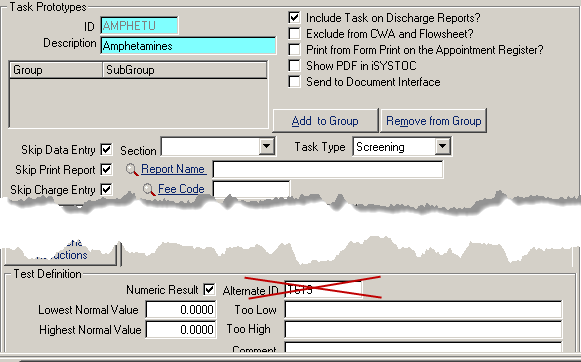Laboratory-Specific IDs
HL7 Drug Test Interface: You must use SYSTOC-defined Laboratory IDs (on the Laboratory screen) and Task Prototype IDs for each substance defined for each laboratory. Consider using the SYSTOC-defined IDs for your most commonly used laboratory even if you are not using the interface. This will save time later if you implement the interface.
SYSTOC-Defined Laboratory IDs
- The Laboratory ID code for Alere must be ALERE
- The Laboratory ID code for Clinical Reference Laboratory must be CRL
- The Laboratory ID code for Quest must be QUEST
- The Laboratory ID code for Medtox must be MEDTOX
If you already have a Lab ID defined for the laboratory you are using the drug test interface and the Lab ID does not match the one shown above, use the Change ID program to change it to the SYSTOC-defined ID.
SYSTOC-Defined Task IDs for Substance Task Prototypes
One task ID is often used for different test variations of a laboratory's substance or for the same substance at different laboratories. For example, the SYSTOC-defined task ID BENZO is used for Benzodiazepines tests that have different CRL lab-specific codes: T611, T711, N371. BENZO is also used for Quest's lab-specific Benzodiazepines code, 72451. However, the task ID BNZ is used for Alere's Benzodiazepines lab-specific code, BNZ.
Contact SYSTOC Customer Support if you have lab-specific codes that are not listed in the reference pages. Provide them with the name of the laboratory, the substance name, and its lab-specific code. A technician will obtain a SYSTOC-defined task ID for you to use and the reference page will be updated as soon as possible.
- Use the Change ID program to change existing substance task ID to
the SYSTOC-defined task IDs. This is the simplest method. Each changed task ID will be
updated with the new ID throughout SYSTOC, including existing results. For example, if
your Amphetamines task ID is AMPH and you are using CRL, change the code to AMPHETU.
If you have multiple Amphetamine task prototypes for CRL, change the most common one and update the Test Protocols that use the other codes with the AMPHETU code. You can also merge the other Amphetamine task prototypes down to the one with the AMPHETU code.
- Add new task IDs as needed to make sure all substances use the SYSTOC-defined task IDs. You must also update all Test Protocols containing test components for which new task IDs were added. For each Test Protocol, delete the old task ID and add the new one. Existing test results are not affected and will continue to show the old task ID.
